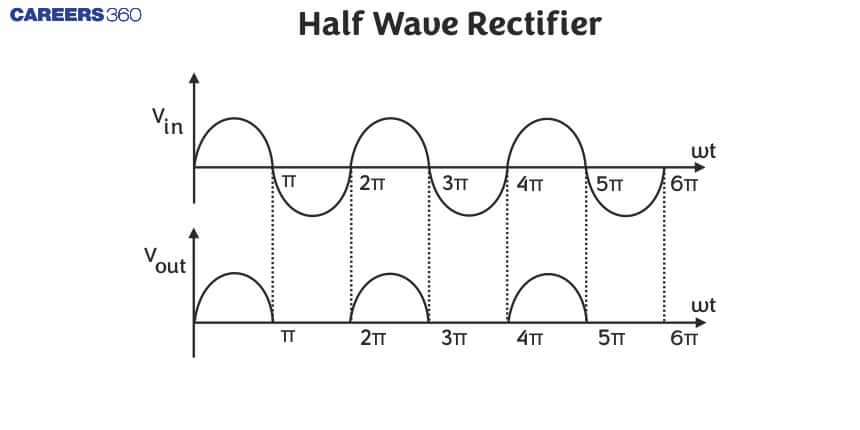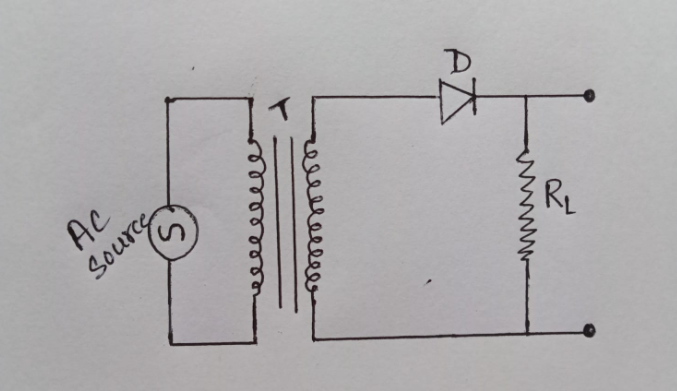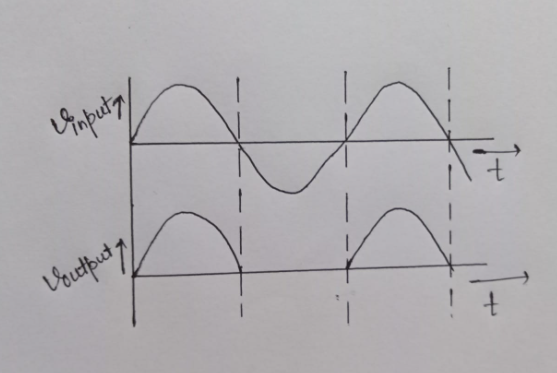Half Wave Rectifier - Definition, Working, Diagram, FAQs
In this article we will learn details about the half wave rectifier .

Half wave rectifier :
Half wave rectifier rectifies the one half of the input AC wave by blocking the other half of the input wave. The output wave will be the half of the input wave .Though the rectifier only corrects the half of the input AC wave , so the rectifier is known as halfwave rectifier .
The p-n junction diode is widely used in the rectification of an alternating current.
Also read -
- NCERT Solutions for Class 11 Physics
- NCERT Solutions for Class 12 Physics
- NCERT Solutions for All Subjects
Circuit configuration of the half wave rectifier :
The basic halfwave rectifier :
- AC source
- A diode
- Load resistance
Sometimes transformers can also be used in the half wave rectifier.
Half wave rectifier circuit diagram / half wave rectifier diagram:

According to the diagram , the T is the transformer, D is the diode And Rl is the load resistance.
Also read :
- NCERT notes Class 12 Physics Chapter 14 Semiconductor Electronics: Materials, Devices and Simple Circuits
- NCERT solutions for Class 12 Physics Chapter 14 Semiconductor Electronics: Materials, Devices and Simple Circuits
- NCERT Exemplar Class 12 Physics Solutions Chapter 14 Semiconductor Electronics Materials Devices and Simple Circuits
Half wave potential and time graph diagram:

Usage of Half wave rectifier :
Half wave rectifier converts AC waves to DC waves .It uses only one diode in the circuit .A half wave rectifier is the simplest form of rectifier among all the rectifiers.
Related Topics link, |
Working principal of half wave rectifier:
In half wave rectification the positive half cycle of alternating current comes as output wave when the p-n junction diode is forward biased with the half wave rectification circuit .The negative half cycle can be produced when the p-n junction is reverse biased with the half wave rectification circuit. It is the working of half wave rectifier.
The ripple factor of half wave rectifier :
Each wave crest in the DC output wave is known as ripple .
Ripple factor of half wave rectifier is, 
Ripple factor of a half wave rectifier helps us to determine that how well the half wave rectifier rectifies the AC wave to DC wave .In a half wave rectifier , the number of wave crests in an alternating input becomes equal to the number of ripples in the direct current output .The ripple factor of a half wave rectifier is more than the full wave rectifier.
1.21 is the ripple factor for the half wave rectifier .
NCERT Physics Notes:
Advantages of half wave rectifier:
- Peak signal can be formed by using half wave rectification.
- Demodulation can be made in a modulated wave by using half-wave rectifier.
The disadvantage of half-wave rectifier:
- Due to half wave rectification, the output signal get weaker than the input signal.
- The power loss occurs because of half wave rectification.
- The half wave rectifier is expensive.
Also check-
Frequently Asked Questions (FAQs)
The arrangement which converts an alternating waveform in a unidirectional waveform, that is an alternating current into a unidirectional current, this type of circuit arrangement is called a rectifier.
The rectifier which rectifies only the one half of the input wave is known as half wave rectifier.
The diode is used to get the wanted crust in the output wave.If the diode is forward biased then the output wave will be positive half of the input wave and if the diode is reversed biased then the output wave will the negative half of the input wave.
The function of the filter in an half wave rectifier is to produce a smooth and noise free output wave.
Each wave crust in the Dc output is known as ripple.